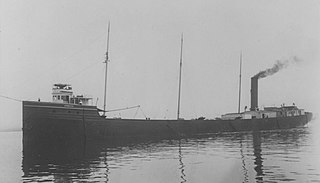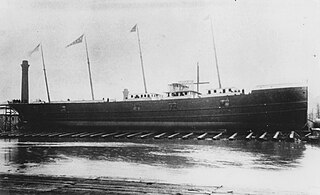
The SS Appomattox was a wooden-hulled, American Great Lakes freighter that ran aground on Lake Michigan, off Atwater Beach off the coast of Shorewood, Wisconsin in Milwaukee County, Wisconsin, United States in 1905. On January 20, 2005 the remnants of the Appomattox were listed on the National Register of Historic Places.

SS Comet was a steamship that operated on the Great Lakes. Comet was built in 1857 as a wooden-hulled propeller-driven cargo vessel that was soon adapted to carry passengers. She suffered a series of maritime accidents prior to her final sinking in 1875 causing the loss of ten lives. She became known as the only treasure ship of Lake Superior because she carried 70 tons of Montana silver ore when she sank. The first attempts to salvage her cargo in 1876 and 1938 were unsuccessful. Comet was finally salvaged in the 1980s when the Great Lakes Shipwreck Historical Society illegally removed artifacts from the wreck. The artifacts are now the property of the State of Michigan and are on display as a loan to the Great Lakes Shipwreck Museum. The fate of her silver ore cargo is unknown. Comet's wreck is now protected by the Whitefish Point Underwater Preserve as part of an underwater museum.

SS D.R. Hanna was a 552-foot (168 m) long American Great Lakes freighter that operated on the Great Lakes from November 12, 1906 to her sinking on May 16, 1919 after a collision with Quincy A. Shaw. D.R. Hanna was like many other freighters, and was used to haul bulk cargoes such as iron ore, coal and grain.

SS Choctaw was a steel-hulled American freighter in service between 1892 and 1915, on the Great Lakes of North America. She was a so-called monitor vessel, containing elements of traditional lake freighters and the whaleback ships designed by Alexander McDougall. Choctaw was built in 1892 by the Cleveland Shipbuilding Company in Cleveland, Ohio, and was originally owned by the Lake Superior Iron Company. She was sold to the Cleveland-Cliffs Iron Company in 1894 and spent the rest of her working life with it. On her regular route between Detroit, Escanaba, Marquette, and Cleveland, she carried iron ore downbound, and coal upbound.

SS Robert Wallace was a wooden-hulled American bulk freighter that served on the Great Lakes of North America from her construction in 1882 to her sinking in 1902 on Lake Superior near the town of Palmers, St. Louis County, Minnesota, United States. On November 17, 1902 shortly after leaving Superior, Wisconsin with a cargo of iron ore, Robert Wallace sprang a leak and sank. Her wreck was found in 2006, and on October 14, 2009, the wreck of Robert Wallace was listed in the National Register of Historic Places.

The SS Lakeland was an early steel-hulled Great Lakes freighter that sank on December 3, 1924, into 205 feet (62 m) of water on Lake Michigan near Sturgeon Bay, Door County, Wisconsin, United States, after she sprang a leak. On July 7, 2015, the wreck of the Lakeland was added to the National Register of Historic Places.

SS Senator was a steel-hulled Great Lakes freighter that sank on Lake Michigan with the loss of nine lives and 268 Nash automobiles, on Halloween of 1929 after she was rammed in heavy fog by the bulk carrier Marquette. She lies in 450 feet (140 m) of water 16 miles northeast of Port Washington, Wisconsin. On April 12, 2016 her wreck was listed on the National Register of Historic Places.

PS Lotta Bernard was a wooden-hulled sidewheel steam barge that served on the Great Lakes from her construction in 1869 to her sinking in 1874. She was built in Port Clinton, Ohio, in 1869 by Lewis M. Jackson for S.W. Dorsey of Sandusky, Ohio. When she entered service, she was chartered by the Northern Transportation Company to carry cordwood from the Portage River and Put-in-Bay to Cleveland, Ohio. In 1870, Lotta Bernard was sold to Luman H. Tenney of Duluth, Minnesota. During this time, she was contracted to haul building materials from Bark Bay, Wisconsin, to Duluth to be used in the construction of the first grain elevator in that port. Lotta Bernard was sold to John D. Howard of Superior, Wisconsin, in 1871.

SS Pere Marquette 18 was a steel-hulled Great Lakes train ferry that served on Lake Michigan from her construction in 1902 to her sinking in 1910.

SS S.R. Kirby was a composite-hulled bulk carrier that served on the Great Lakes of North America from her construction in 1890 to her sinking in 1916. On May 8, 1916, while heading across Lake Superior with a cargo of iron ore and the steel barge George E. Hartnell in tow, she ran into a storm and sank with the loss of all but two of her 22-man crew off Eagle Harbor, Michigan. For over 102 years the location of S.R. Kirby's wreck remained unknown, until June 2018, when her wreck was discovered by the Great Lakes Shipwreck Historical Society (GLSHS) in 825 feet (251 m) of water, completely broken up.

SS Russia was an iron-hulled American Great Lakes package freighter that sank in a Lake Huron gale on April 30, 1909, near DeTour Village, Michigan, with all 22 of her crew and one passenger surviving.

SS Jarvis Lord was a wooden-hulled American Great Lakes freighter in service between 1872 and 1885. She sank without loss of life in the Manitou Passage on Lake Michigan on August 17 or 18, 1885, while loaded with iron ore.

SS Vernon was a wooden-hulled American passenger and package freighter that sank in a Lake Michigan storm on October 29, 1887, near Two Rivers, Wisconsin, with the loss of between 36 and 50 lives, making her one of the deadliest shipwrecks ever to have occurred in Wisconsin. Only one of the people on board survived.

SS John V. Moran was a wooden-hulled American package freighter in service between 1888 and 1899. She was built in 1888 in West Bay City, Michigan, by F.W. Wheeler & Company. She was built for Ward's Crescent Transportation Company of Detroit, Michigan, and was operated as part of his Detroit & Lake Superior Line. She was built to haul both bulk, and package freight. Throughout the 1893 shipping season, John V. Moran ran between Buffalo, New York, and Duluth, Minnesota. She was sold for the first time in 1895 to the Union Transit Line of Buffalo, and once again in 1898 to the Crosby Transportation Company of Milwaukee, Wisconsin.

SS Merchant was an American iron–hulled passenger and package freighter in service between 1862 and 1875. The first iron–hulled merchant ship built on the Great Lakes, she was built in 1862 in Buffalo, New York, by the David Bell shipyard, out of components manufactured in Black Rock, New York, and Philadelphia, Pennsylvania. She was built for James C. and Edwin T. Evans of Buffalo, under whom she carried passengers and freight. Merchant made her maiden voyage in August 1862, sailing from Buffalo to Chicago. Between late 1872 and early 1873, she was lengthened by 30 feet (9.1 m), and had her passenger cabins removed. Also in 1873, Merchant was sold to the Erie & Western Transportation Company of Erie, Pennsylvania.

SS John Mitchell was a steel-hulled, American lake freighter in service between 1907 and 1911. She was built in 1906 by the Great Lakes Engineering Works in St. Clair, Michigan, for the Cornell Steamship Company of Chicago, Illinois, which was managed by C.W. Elphicke. She entered service in 1907, and had a sister ship named William B. Davock. Throughout her career, John Mitchell carried iron ore and coal. On October 4, 1908, she ran aground at Indiana Harbor, Indiana, while loaded with iron ore.

SS Cayuga was a steel-hulled American package freighter in service between 1889 and 1895. She was built in 1889 in Cleveland, Ohio, by the Globe Iron Works Company for the Lehigh Valley Transit Company of Buffalo, New York. One of five identical sister ships, Cayuga entered service in 1889, carrying package freight between Buffalo and Chicago, Illinois, also making stops in Milwaukee, Wisconsin, and Gladstone, Michigan. Throughout her brief career, Cayuga was involved in two accidents. In the first in 1890, when she went aground in a gale just outside of Buffalo harbour; six tugboats managed to pull her free that same day. The second accident occurred in 1891, when Cayuga was involved in a collision with the package freighter Delaware near Cheboygan, Michigan.

SS Lac La Belle was a wooden-hulled American package freighter in service between 1864 and 1872. She was built in 1864 in Cleveland, Ohio, by Ira Lafrinier for Hanna & Garretson, also of Cleveland. She had an identical sister ship named Ironsides. Lac La Belle operated between Cleveland and Lake Superior for a number of years, and was sold several times. In 1869, she was sold to Nathan Englemann of Milwaukee, Wisconsin, and operated between Milwaukee and Grand Haven, Michigan. In 1871, she became part of the Englemann Transportation Company. Throughout her career, Lac La Belle was involved in several accidents.

PS Keystone State was a wooden-hulled American paddle steamer in service between 1849 and 1861. She was built in 1848 in Buffalo, New York, by Bidwell & Banta for ship-owner Charles M. Reed of Erie, Pennsylvania, and operated as part of his "Chicago Line". A luxuriously furnished palace steamer, she operated between Buffalo and Chicago, Illinois, while also making stops at various other ports. She was built for the passenger and package freight trade, frequently carrying both wealthy passengers and European immigrants who desired to settle in the Midwestern United States. Due to the Panic of 1857, Keystone State and several other paddle steamers were laid up. When the American Civil War began in 1861, she was refurbished, and put back into service.

SS Chester A. Congdon was a steel-hulled American lake freighter in service between 1907 and 1918. She was built in 1907 by the Chicago Shipbuilding Company of South Chicago, Illinois, for the Holmes Steamship Company, and was intended to be used in the grain trade on the Great Lakes. She entered service on September 19, 1907, when she made her maiden voyage. In 1911, Salt Lake City was sold to the Acme Transit Company. A year later, she was transferred to the Continental Steamship Company, and was renamed Chester A. Congdon, after lawyer and entrepreneur Chester Adgate Congdon. She was involved in several accidents throughout her career.






















